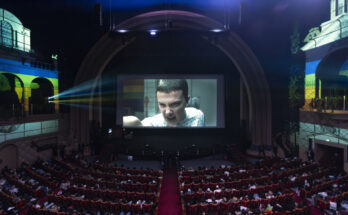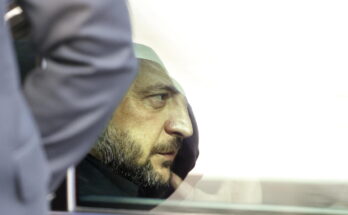Heis an often overlooked page in the history of the seventh art: France played a central role in the emergence of western art. If the genre was indeed born on the other side of the Atlantic in the early 20th centurye this century, with the founding of the first film studio in Hollywood, films featuring cowboys and Indians were soon filmed in Paris and its environs.
In 1904 (only one year after release The Great Train Robberythe first “American-made” western), Gaston Velle, a cinematographer working for the Lumière brothers, immortalized on film two proposed choreographic paintings at the Casino de Paris and entitled Kickaboo Dance And Apache Ceremony.
The success of these films encouraged the budding industry to increase the amount of fiction inspired by these themes. This was the beginning of what scholars call “camembert westerns,” long before “spaghetti westerns.” It is this unique and little-known adventure that is told in a retrospective proposed by the Pathé-Jérôme Seydoux foundation in Paris, starting November 19.
Jean Hamman’s founding journey
It all started in 1906. A young Frenchman, Jean Hamman (1883-1974), played the main role in a film called The Cowboyabout the daily life of one cattle herder’s son living on the great plains of the New World. The short film, now lost, was shot at the Lux studios in the Bois de Boulogne (Paris), on the Mer de Sable (Fontainebleau) and at the Arcueil mine (currently Val-de-Marne). Afterwards, Charles and Émile Pathé started several similar films in Vincennes and Meudon.
In 1907, Jean Hamman, then still an actor, moved behind the camera. Descended from a line of painters (paternal side) and members of the court of Napoleon III (maternal side), this Parisian was educated at the Condorcet secondary school. At the age of 24, he would write an important chapter in the history of French cinema.
A trip to the United States, taken with his father right after his baccalaureate degree, introduced him to the great American West. During these trips, he learned to ride horses on a ranch in Montana and began to develop an imagination in which Buffalo Bill occupied a central place. A former buffalo hunter who turned to show business is now a circus boss. He created a troupe that performed large equestrian shows.
Upon returning to France, Jean Hamman was inspired by this model. He firmly believed that the world of the Wild West could captivate European audiences. He began writing a screenplay based on what he saw and decided to Americanize his first name to give it more “local color.” Under the name Joë Hamman he participated, in the following decades, in no less than a hundred films; sometimes as a screenwriter, sometimes as an actor, sometimes not as a stuntman, director, or producer…
Camargue decoration
Joë Hamman worked mostly with director Jean Durand, a former journalist who also wanted to tell the story of the conquest of the West in a new way. Unable to film in the United States, the two men turned their intrigue to the Paris suburbs before taking the Camargue as their setting.
This is because one of their friends, the writer Folco de Baroncelli, opened the doors of the manade in Saintes-Maries-de-la-Mer (Bouches-du-Rhône) to them in 1908. He provided them with his horses, bulls and livestock. “The setting is decidedly un-American with lakes full of reeds and low houses with roofs covered in sagne, but the mix of genres doesn’t scare Joë Hamman,” smiles Samantha Leroy, who selected the films for a Pathé Foundation retrospective.
Programmers discovered about twenty westerns worked on by Joë Hamman. The oldest is from 1911. The description is very brief. The duration varies between 6 and 12 minutes. The first one is titled Hanging in Jefferson City and tells the story of a miscarriage of justice: the death penalty for a man named Burton, accused of murdering his friend Bill, who in reality accidentally disappeared on the day he gave the miners their wages.
Early westerns dealt with a wide variety of themes. There are blueberries there. Like Marital revolverwhich details the adventures of Maud Baker, a young woman who falls in love with a cowboy, much to her uncle’s dismay. Like that again Burning Heartwhere Sun Ray, the daughter of Chief Sitting Bear, wants to marry a penniless hunter. Or even Borneo Bill, brave cowboya previously unreleased film was discovered in the cinema library of Belgrade (Serbia). A film that is a variation on a theme Romeo and Juliet…a hero who falls in love with the daughter of his worst enemy.
Joë Hamman’s cinema is famous for its action scenes. One hundred dollars, dead or alive thus containing the first major fight in a saloon. And Burning Grasslands Instead, in dramatic fashion, an Indian chief is determined to exact revenge on the government agents who humiliated him. But some of these films are full of humor. This is the case Calino wants to be a cowboy, whose hero is a suburban kid who dreams of participating in the gold rush and practice throwing the lasso into the… Bagnolet.
Very rich filmography
However, reducing Joë Hamman to only films that glorify the American West would be a mistake. As director Vincent Froehly, author of a documentary dedicated to the filmmaker (scheduled for November 22), explains, “Hamman abruptly stopped playing cowboys in the late 1920s, when Hollywood began exporting its first productions to France.” Unable to compete with the big American studios, he began producing feature films that raised other themes.
With Zigoto uses a plumberit explores the farce genre. The hero is a bumbling boy determined to fix a gas leak with the results we imagine. Joë Hamman plays a secondary role, a neighbor whose apartment is destroyed by a domestic disaster. In series Rouletabille among the Bohemians (lasting over six hours!), the actor-filmmaker’s take on the thriller, takes viewers on the trail of a thief, Hubert de Lauriac…
READ ALSO Bernard Natan, the forgotten legend of cinemaNo topic seems to scare Joë Hamman. In 1923, he produced a fantastic series in ten episodes whose hero, Tao, was a dragon-headed teenager who frightened the inhabitants of a distant country where he tried to take over the oil fields! In the same year, he entrusted Jean Kemm to create Child King. A cine-novel, as the series is called, traces the story of Louis XVI’s son, from his childhood at Versailles to the Revolution. Joë Hamman wearing a Knight Mallory costume.
In addition to these silent films, the latter of which were tinged with orientalism, Joë Hamman directed (or acted in) more than ten talkies. Especially the adaptation of Alder King by Goethe in 1931, directed by Marie-Louise Iribe and in which he played the main role.
A retrospective from the Jérôme Seydoux-Pathé Foundation allows us to rediscover the feature films that were huge successes of the time. Especially thanks to his loyal actors: Gaston Modot and Berthe Dagmar. Don’t miss the adaptation Mireillea novel by Frédéric Mistral, brought to the screen in 1933 by René Gaveau and Ernest Servaès, in which Joë Hamman plays the sensitive Ourias in a love story thwarted by social prohibitions.
The actor also appeared in two biographical films dedicated to Napoleon. Starting with Abel Gance, but also Sacha Guitry where he lent his features to Kellerman. “Joë Hamman continued to make films into the 1960s, focusing primarily on criminal characters,” says Vanessa Leroy.
The actor published his memoirs entitled From the Wild West to Montmartrein 1962. His star then faded. He made his last appearance on the big screen, in front of the camera of Francis Leroi, in a film, somewhat erotic, quite heartbreaking, Pop Games.
To find
Kangaroo today
Answer
He spent his last years running an “entertainment center” in the Jardin d’acclimatization. Kids do pony tricks and learn to use a whip and lasso. He received journalists at his museum apartment in Porte de Champerret, where he showed them his old costumes, his toy soldiers, and his drawings and paintings – because he was also an artist. While telling them about the adventures of his youth. He ended his life far from Paris, in Dieppe where he died on 30 June 1974.
* Retrospective “Joë Hamman, the Frenchman who discovered the west”, at the Jérôme Seydoux-Pathé Foundation, in Paris, from November 19 to December 16, 2025.



